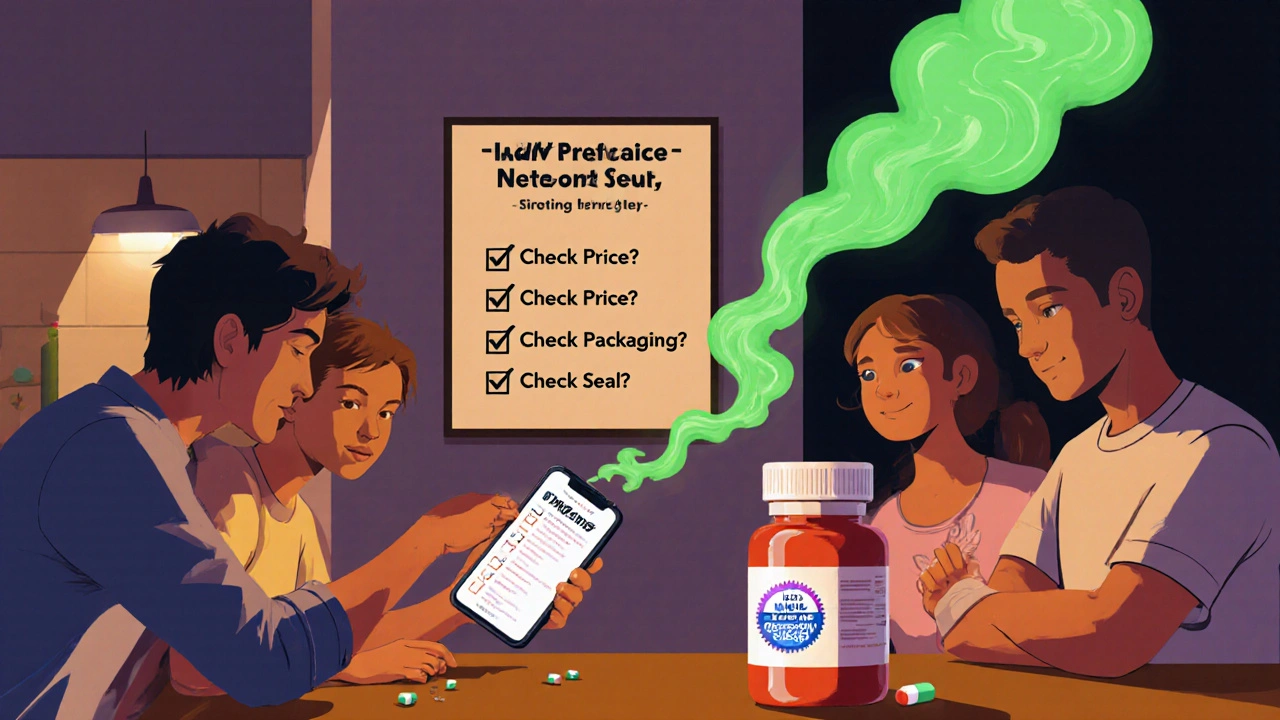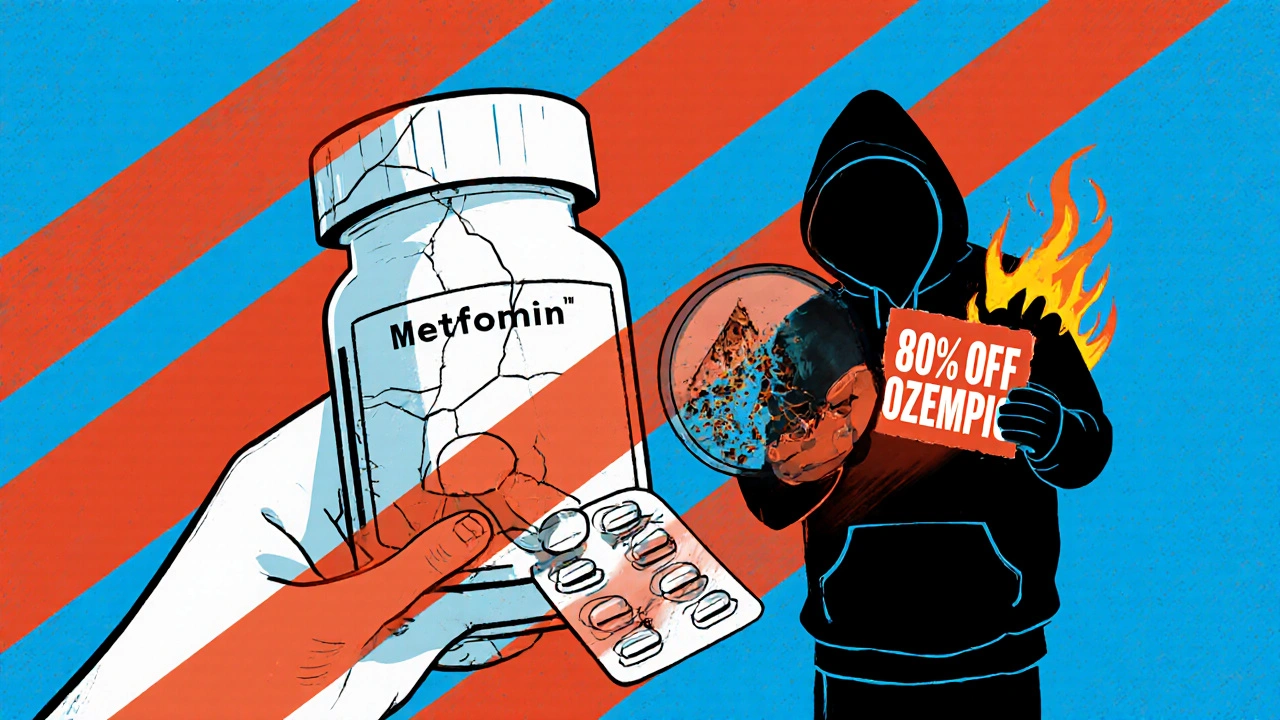Every year, hundreds of thousands of people around the world get sick or die from fake medicines. These aren’t just poor-quality copies-they’re dangerous. Some contain no active ingredient at all. Others have deadly doses of fentanyl, amphetamines, or rat poison. And they look real. So real, in fact, that even pharmacists can be fooled without checking the right signs.
Price That Seems Too Good to Be True? It Probably Is
If you’re buying medication online and the price is 50% or more below what you pay at your local pharmacy, walk away. Legitimate pharmaceutical companies don’t discount their drugs that heavily. Truemed’s 2024 analysis found that real prescription drugs rarely drop more than 20% off retail, even during sales. Counterfeiters, on the other hand, lure buyers in with discounts of 60% to 80%. A bottle of Ozempic that normally costs $969 a month might be listed for $250 online. That’s not a deal-it’s a trap. Consumer Reports found that 87% of websites offering prices 60% below retail were selling fake drugs. The FDA warns: if it sounds too cheap, it’s probably fake.Packaging That Looks Off
The packaging is often the first place counterfeiters slip up. Even the best forgers can’t perfectly copy the exact ink, paper, or embossing used by major manufacturers. Look closely:- Spelling errors: 63% of counterfeit drugs have typos on the label-"Vigra" instead of "Viagra," "Metfomin" instead of "Metformin."
- Missing or wrong batch numbers: 41% of fake pills have numbers that don’t exist in the manufacturer’s system. Pfizer says 37% of counterfeit lot numbers are completely fake.
- Blurry printing: Hold the box up to the light. If the text looks pixelated or smudged at 10x magnification, it’s a red flag.
- Wrong expiry date: Dates that don’t match the production timeline or are printed in a different font are suspicious.
- Seal that looks resealed: If the tamper-evident cap or shrink wrap feels loose or like it’s been glued back, don’t take the pills.
Tablets or Capsules That Don’t Look or Feel Right
Real pills are made with precision. They have consistent weight, size, and coating. Counterfeit versions often look different:- Weight: Legitimate tablets vary by no more than 5% in weight. Fake ones can be noticeably lighter or heavier.
- Shape and color: Even slight differences in shade or texture matter. If your metformin is now a pale yellow instead of white, or your Viagra is slightly thicker, ask your pharmacist.
- Surface flaws: Cracks, bubbles, or crumbling edges mean the tablet wasn’t made under sterile, controlled conditions.
- Smell: Many users report fake pills have a chemical or plastic odor. One Reddit user described a counterfeit oxycodone pill that smelled like "burnt plastic and mint."

Medication That Doesn’t Work-or Makes You Sick
If your blood pressure hasn’t dropped after a week on your new pills, or your diabetes is suddenly harder to control, something’s wrong. At the American Pharmacists Association’s 2024 meeting, 73% of pharmacists said they identified counterfeits after patients reported their meds weren’t working. In one case, patients taking fake metformin experienced severe low blood sugar because the pills contained glyburide, a completely different diabetes drug. Another patient reported chest pain after taking what they thought was generic Cialis-it turned out to contain amphetamine. The FDA says 22% of counterfeit medications contain the wrong active ingredient entirely.Online Pharmacies That Don’t Require a Prescription
Any website that sells prescription drugs without asking for a valid prescription is illegal-and almost always selling fakes. The DEA found that 92% of verified counterfeit cases came from pharmacies that skipped this basic safety step. In the U.S., only about 6,214 online pharmacies are verified by the National Association of Boards of Pharmacy (NABP) and carry the .pharmacy domain. There are over 35,000 illegal ones. Before buying anything online, check the NABP’s website to confirm the site is legitimate. If the URL ends in .com, .net, or .xyz and doesn’t say .pharmacy, it’s not safe.What to Do If You Suspect a Fake
Don’t throw it away. Don’t take it. Don’t just stop using it. Take action:- Stop taking the medication immediately.
- Take a photo of the packaging and pills.
- Call your pharmacist. They can compare it to the real product.
- Check the manufacturer’s website. Most, like Pfizer and Janssen, have online verification tools where you can enter the lot number.
- Report it to the FDA through MedWatch. You can do it online in under five minutes. The FDA updates its counterfeit drug database hourly, and your report helps protect others.
Pharmacists who complete the DEA’s 2024 Pharmacist Verification Certification Program have seen counterfeit dispensing drop by 63%. That’s because they know what to look for-and they’re trained to act.

Why This Is Getting Worse
Counterfeiters are getting smarter. AI now generates packaging that fools 68% of consumers on first glance. New pills are made to match real ones down to 0.1mm in size and exact Pantone colors. But they still fail under microscopic analysis. Legitimate holograms contain microtext invisible to the naked eye-counterfeits copy the shape but not the detail. The WHO says 95% of fake holograms look real until you zoom in at 50x magnification.And the drugs being faked are changing. In 2024, 42% of seized counterfeit medicines targeted heart medications, 29% were for erectile dysfunction, and 18% were weight-loss drugs like Ozempic. Why? Because they cost over $1,000 a month. Huge profit margins. The DEA warns that counterfeit GLP-1 agonists will surge 200% by 2026. Even biologics like Humira are being copied-fake versions that don’t need refrigeration, which means they’re useless and dangerous.
How to Protect Yourself
- Buy only from licensed pharmacies you know and trust. If you’re ordering online, use only .pharmacy sites. - Never buy from social media ads, pop-ups, or text messages. - Keep your old prescription bottles. Compare new pills to old ones-color, shape, markings. - Ask your pharmacist to verify the source of your medication. They’re trained to spot fakes. - Use the FDA’s National Drug Code Directory to check if your drug’s NDC code is registered.The global anti-counterfeiting market is now worth $3.8 billion-and growing. New tech like microscopic luminescent tags (FDA’s PharmMark system) will make fakes easier to detect by 2026. But until then, your eyes and instincts are your best tools.
Real Stories, Real Risks
In 2023, a woman in Ohio bought fake insulin online to save money. She didn’t know the pills contained no insulin at all. Within days, she was hospitalized with diabetic ketoacidosis. Her story made headlines-but it’s not rare. The WHO estimates 500,000 deaths a year in Sub-Saharan Africa alone are tied to fake malaria and pneumonia drugs. In Hungary, counterfeit Viagra pills contained amphetamine. In the U.S., 100% of fake opioid pills seized in 2024 had lethal doses of fentanyl.You’re not just risking your wallet. You’re risking your life.
How can I tell if my medication is fake just by looking at it?
Look for spelling mistakes, blurry printing, or mismatched colors and shapes compared to your previous refill. Check the packaging seal-if it looks tampered with or resealed, that’s a red flag. Fake pills often have uneven edges, cracks, or a strange smell. Even small differences in size or weight can mean it’s counterfeit. Use manufacturer reference images online to compare.
Are fake drugs only sold online?
Most counterfeit drugs are sold online, especially through unverified websites, social media ads, or text message scams. But fake pills can also appear in physical pharmacies, especially in countries with weak regulation. Even in the U.S., counterfeit drugs have been found in supply chains that bypass proper verification. Always buy from licensed pharmacies you trust.
What should I do if I took a fake pill?
Stop taking it immediately. Call your doctor or pharmacist and describe what happened. If you feel sick-dizziness, chest pain, nausea, or unusual symptoms-seek medical help right away. Report the product to the FDA through MedWatch. Even if you feel fine, the drug may have hidden ingredients like fentanyl or amphetamines that can cause delayed harm.
Can I trust pharmacies that offer huge discounts?
No. Legitimate pharmacies rarely discount prescription drugs by more than 20%. Discounts of 50% or more are almost always a sign of counterfeit medication. The DEA and FDA warn that websites offering prices 60% below retail have an 87% chance of selling fake drugs. Save money by using insurance, patient assistance programs, or generic alternatives-not by buying from shady online sellers.
How do I know if an online pharmacy is real?
Look for the .pharmacy domain-this means the site is verified by the National Association of Boards of Pharmacy (NABP). Only about 6,200 sites have this certification. You can check the NABP website to verify a pharmacy. Also, a real online pharmacy will always require a valid prescription. If they don’t ask for one, it’s illegal and unsafe.
Are there any new technologies to detect fake drugs?
Yes. The FDA is rolling out PharmMark-a microscopic marking system using luminescent nanoparticles that glow under UV light. Only legitimate drugs will have this. By 2026, it’ll be required on all controlled substances. Blockchain tracking and unique identifiers on packaging are also being adopted in the EU and will expand in the U.S. by 2030. But these systems aren’t everywhere yet. For now, your eyes and reporting suspicious products are still the most powerful tools.
